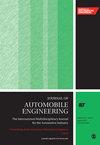基于非奇异快速终端滑动模式的牵引车偏航稳定性控制
IF 1.5
4区 工程技术
Q3 ENGINEERING, MECHANICAL
Proceedings of the Institution of Mechanical Engineers Part D-Journal of Automobile Engineering
Pub Date : 2024-09-06
DOI:10.1177/09544070241272772
引用次数: 0
摘要
偏航稳定性对于商用牵引车辆非常重要,本文研究了基于非正弦快速终端滑动模式的牵引车辆偏航稳定性控制。首先,选择鲁棒性较高的滑动模态控制作为偏航力矩控制器,并推导出传统滑动模态、快速终端滑动模态和非奇异快速终端滑动模态(NFTSM)。监测后轴侧偏角,改进传统的偏航稳定性控制策略。在计算执行器响应值时,在传统的目标制动压力计算基础上增加了目标滑移率和目标发动机扭矩的计算,并在扭矩计算部分引入了可变参数 PID 方法,以改善扭矩控制效果。进行了仿真和实车测试,结果表明所开发的非奇异快速终端滑模控制器的效果明显优于快速终端滑模方法,且具有较强的车辆方向稳定性。本文章由计算机程序翻译,如有差异,请以英文原文为准。
Yaw stability control of tractor vehicle based on nonsingular fast terminal sliding mode
Yaw stability is very important for commercial traction vehicles, the yaw stability control of traction vehicle based on nonsingular fast terminal sliding mode is studied in this paper. Firstly, the sliding mode control with high robustness is selected for the yaw moment controller, and the traditional sliding mode, fast terminal sliding mode, and nonsingular fast terminal sliding mode (NFTSM) are derived. The rear axle side deflection angle is monitored, and the traditional yaw stability control strategy is improved. When computing actuator response value, the calculation of the target slip rate and the target engine torque are added on the basis of the traditional calculation of the target braking pressure, and the variable parameter PID method is introduced in the torque calculation part to improve the effect of torque control. A simulation and a real vehicle test are carried out, and the results show that the effect of the developed nonsingular fast terminal sliding mode controller is significantly better than the fast terminal sliding mode method and has strong vehicle directional stability.
求助全文
通过发布文献求助,成功后即可免费获取论文全文。
去求助
来源期刊

CiteScore
4.40
自引率
17.60%
发文量
263
审稿时长
3.5 months
期刊介绍:
The Journal of Automobile Engineering is an established, high quality multi-disciplinary journal which publishes the very best peer-reviewed science and engineering in the field.
 求助内容:
求助内容: 应助结果提醒方式:
应助结果提醒方式:


